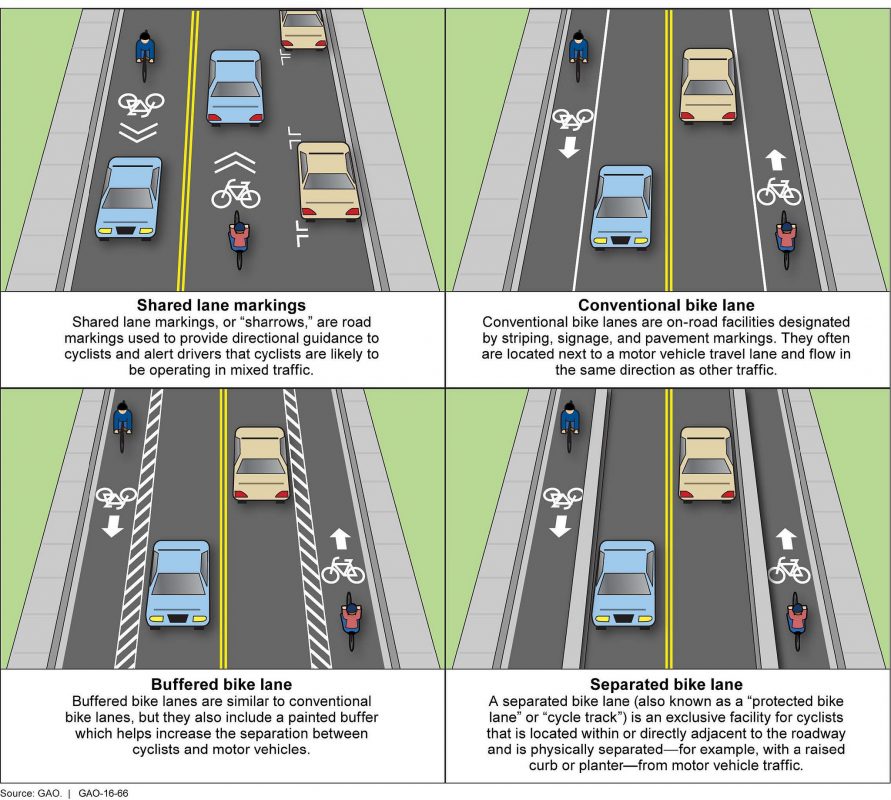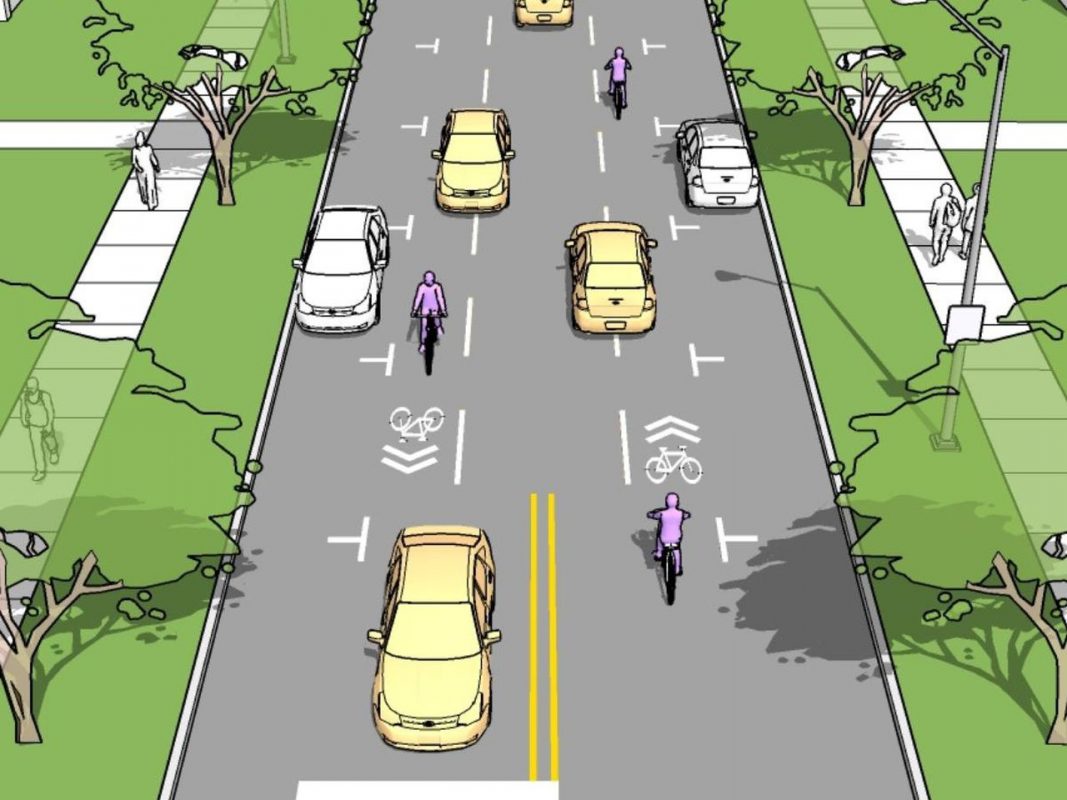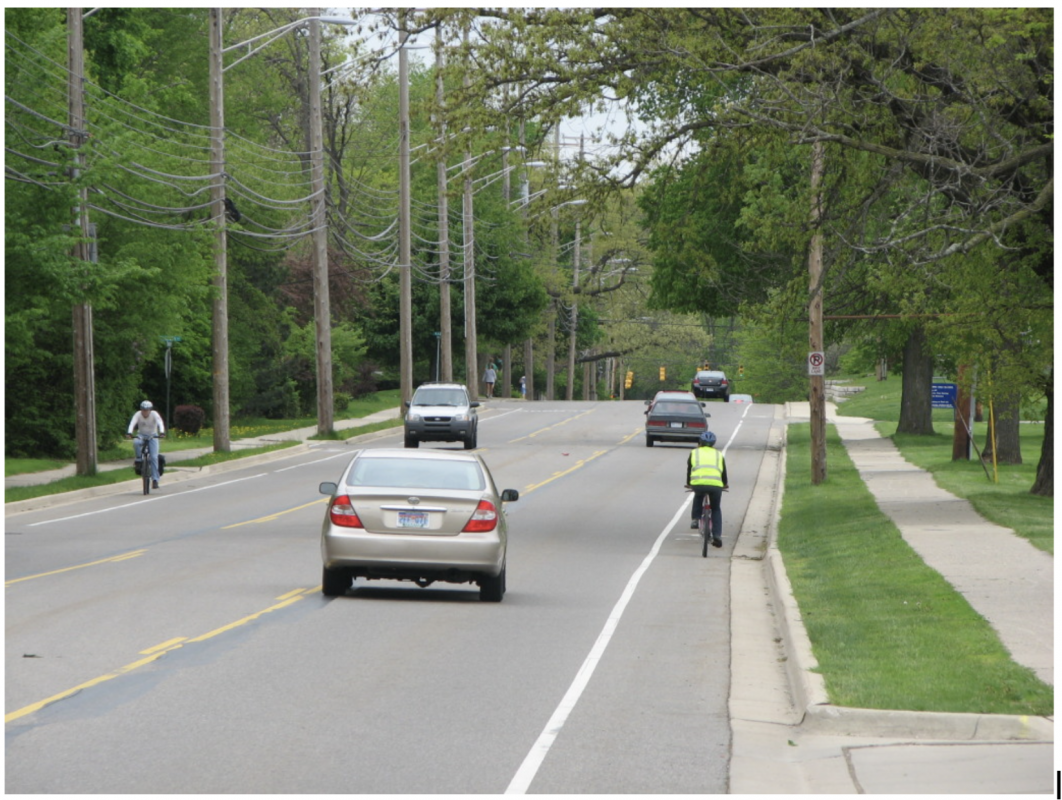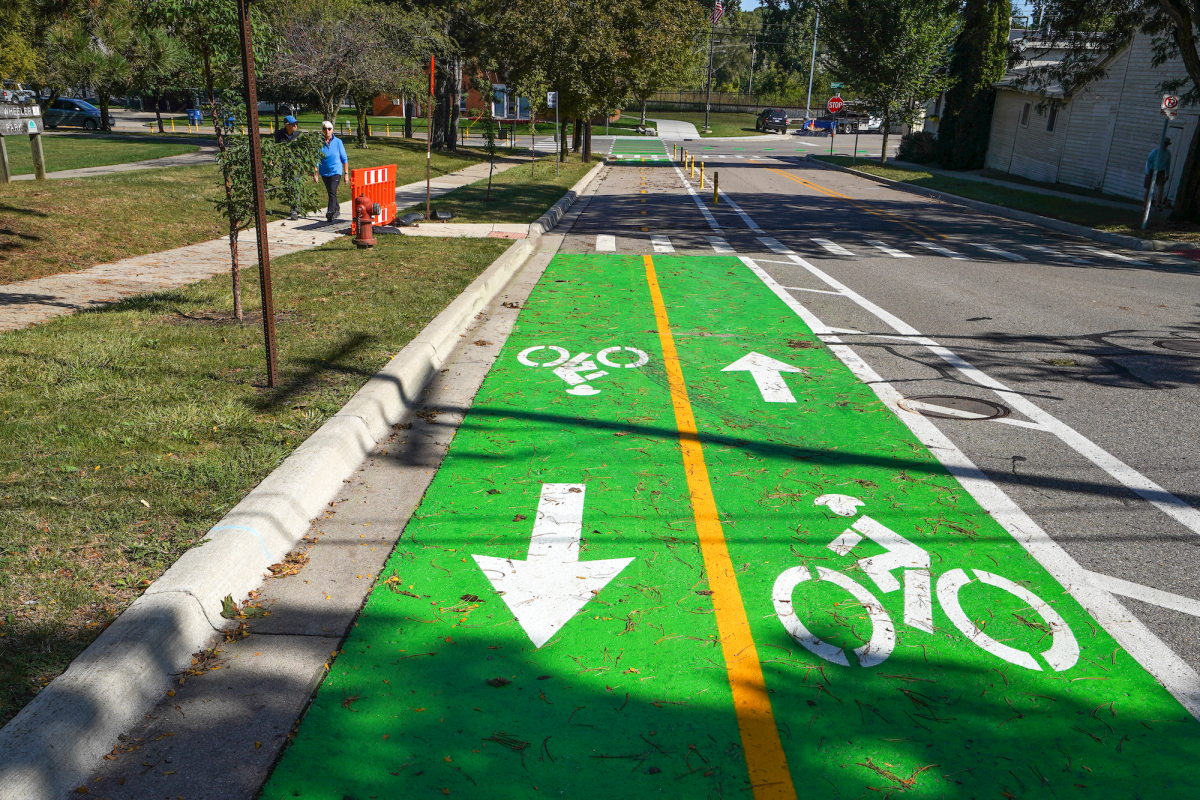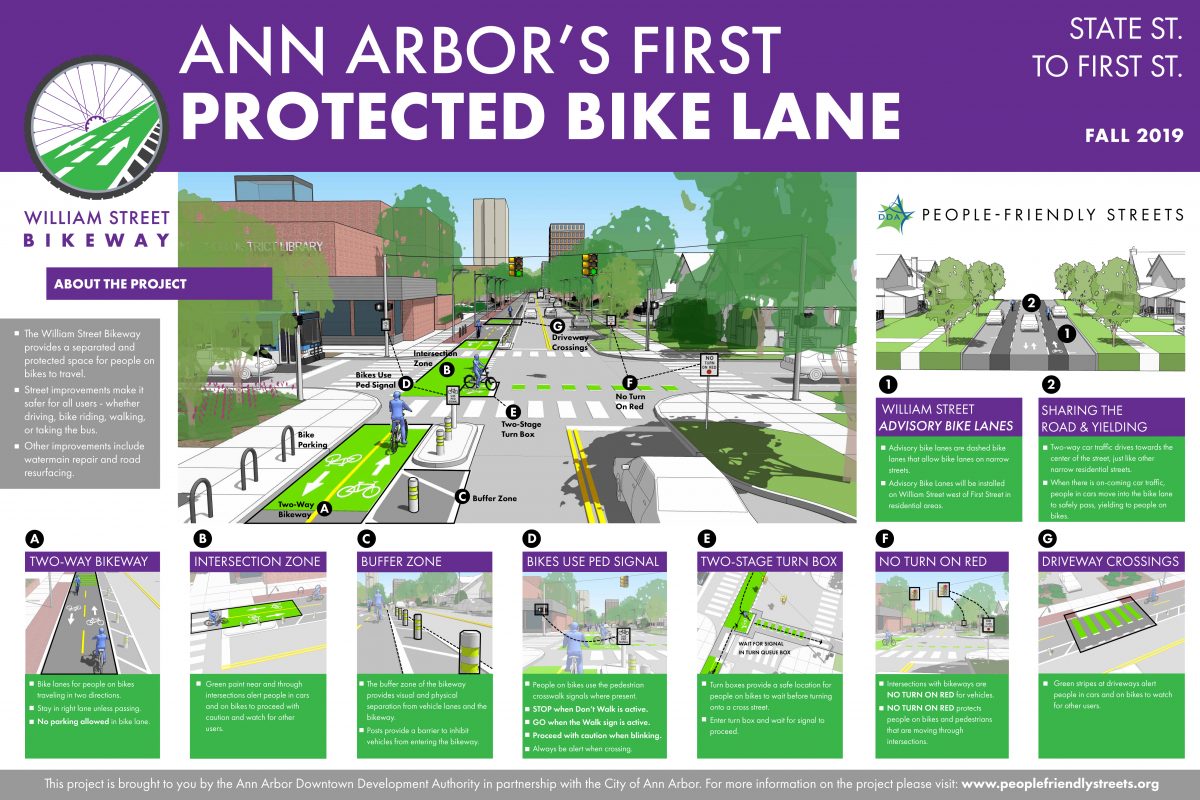The City of Ann Arbor and the Ann Arbor Downtown Development Authority have been actively planning and building bicycling and pedestrian infrastructure for several years in Ann Arbor. No doubt you have noticed the changes when traveling around town.
For many residents, protected bike lanes, shared use roads, pedestrian bump-outs, and more are simply appearing before our eyes with little understanding of the objectives and goals behind them. Read on to find out what changes are being made to our downtown streets, why they are being undertaken, and where to find out more information if you want to get involved with the process.
Ann Arbor bicycle transportation facts:
- The City of Ann Arbor has 90.1 lane miles of on-street bike lanes, 79 miles of shared-use paths, 11.3 lane miles of marked shared lanes (sharrows), 1.2 protected bike lane miles, and 7.0 buffered bike lane miles.
- There are over 900 bike parking spaces in downtown Ann Arbor, including 431 bike hoops, 6 on-street bike racks accommodating 16 bikes each, and 26 secured bike lockers. Bicycle parking is required in new developments.
- The League of American Bicyclists has awarded the City of Ann Arbor a Gold-level Bicycle Friendly City Award in 2021. Ann Arbor has long been a leader in creating and fostering bicycle-friendly streets.
The Ann Arbor Downtown Development Authority’s People-Friendly Streets Goals
The People Friendly Streets plan is built on the premise that streets are for ALL people – not just automobiles. And that by designing and building them with this in mind, They can:
- IMPROVE SAFETY AND COMFORT – Create safe and comfortable streets for everyone for all modes of travel.
- PROMOTE GREEN DESIGN – Use practices that protect air and water quality.
- STRENGTHEN BUSINESSES- Increase access to local businesses while supporting commercial operations.
- INCREASE ACCESS & CONNECTIVITY – Connect people to where they want to go and make it easy to get there by foot, bike, car, and bus encouraging people to connect to each other and the community around them.
- DESIGN RESPONSIBLY – Keep people in mind throughout the process. Design streets that make the best use of public dollars for the benefit of all.
- CELEBRATE CIVIC LIFE & ACTIVITY – Streets that are fun and interesting and celebrate the character of downtown.
What Physical Changes is the DDA Making to Improve Bicycling In Ann Arbor?
Here are 4 types of bike lanes that are being implemented in Ann Arbor to meet the coordinated goals of the DDA and the City of Ann Arbor.
Shared Bicycle Lanes, or “Sharrows”
Advisory bike lanes or Sharrows add bike lanes to a road where they may not otherwise fit. This is the case on low-speed, narrow local streets such as Ashley between William and Madison. They are generally used by experienced cyclists and commuters. They are common in bike-friendly cities such as Denver and Portland. Studies have shown that in the presence of the markings cyclists moved further away from parked cars and passing motorists moved further away from cyclists than in the absence of them.
Having visited Portland several times, these shared roads are common though denser neighborhoods throughout the city. They are heavily used and residents have become used to them just as we have gotten used to traffic circles. They allow “bikers with a purpose” — primarily commuters and transportation riders — to ride quickly through town in semi-dedicated road space. The convenience of these lanes allow bikers to travel faster than cars through these neighborhood streets.
Here are two videos that explain how Sharrows work.
Conventional Bike Lanes
Conventional bike lanes have been around for a while and most drivers are familiar with them. They are designed for enthusiastic and confident riders as there is no physical barrier between them and automobile traffic. Ann Arbor has miles of these in place. Many have colored paint treatments at the crosswalks. These are perfect for wide streets with space dedicated bike and automobile traffic. As bicyclists will be traveling on city streets, those streets can be made safer and more comfortable for everyone by providing bike lanes. Bike lanes:
- Support and encourage bicycling as a means of transportation.
- Help define road space to promote a more orderly flow of traffic
- Encourage bicyclists to ride in the correct direction, with the flow of traffic.
- Give bicyclists a clear place to be so they are not tempted to ride on the sidewalk
- Remind motorists to look for cyclists when turning or opening car doors
- Signal motorists that cyclists have a right to the road
- Reduce the chance that motorists will stray into cyclists’ path of travel
- Make it less likely that passing motorists to swerve toward opposing traffic
- Decrease the stress level of bicyclists riding in traffic
Buffered Bike Lanes
Buffered or Separated Bike Lanes are similar to conventional bike lanes but they also include a painted buffer which helps increase the separation between cyclists and motor vehicles. These lanes are for riders of all skill levels.
Benefits of Separated or Buffered Bike Lanes:
- Increase comfort and safety for bicyclists through separation from motor vehicles to create a more path-like experience.
- More comfortable and accessible for people of all ages and abilities, including children and the elderly; attract new riders at all levels.
- Reduce crashes, overall injury risk, and fear of collisions with over-taking vehicles at mid-block.
- Remove bicyclists from the door zone, eliminating the risk of “dooring” and potentially being struck by a motor vehicle.
- Reduce or eliminate potential obstructions that occur commonly in bicycle lanes, such as motorists parking or driving in the lane.
- Providing a dedicated space for bicyclists improves clarity about expected behavior for all modes of travel.
- Enhance the pedestrian environment by creating a buffer between pedestrians and vehicle traffic adjacent to the sidewalk.
- Encourage traffic-averse cyclists to ride in a bicycle facility, rather than on the sidewalk
- Narrow the roadway width, either physically or visually, for traffic calming benefits and to help create a more human-scale environment.
- Reduce or separate conflicts with motorists.
- Provide a better air quality environment for users than riding in the roadway. The increased separation from motor vehicle traffic also provides better air quality for pedestrians.
- Provide economic benefits — they attract more bicyclists than standard bike lanes which results in more productive workers and more spending at local businesses.
Protected Bike Lanes
Protected bike lanes result in 39% fewer vehicle/bicycle accidents and 59% fewer overall injuries for bicyclists. In a study conducted by Breakaway Research Group for People for Bikes in 2015, the majority of Americans said they wanted to bike more but 54% cited a fear of getting hit by a car as something that holds them back.
There are now protected bike lanes on Ashely, E. William, and Division streets in downtown Ann Arbor. These are the most expensive to construct and create the most separation between cyclists and automobiles. They offer the greatest safety advantage for cyclists as well.
Protected bike lanes are safer for more users:
- Provides physical separation between bike and vehicle lanes (e.g. flex-posts, medians, parked cars).
- Can be one-directional or bi-directional
- Provides legitimacy to cyclists using streets
- Provides fewer conflicts with motorists and pedestrians.
- Increases retail and food sales according to studies in New York City and Toronto
- Increase in cycling overall
The next time you are in Ann Arbor, look out for these 4 types of bicycle lanes and become more comfortable in how to interact with them. they take some getting used to but the benefits to the people and the City of Ann Arbor are significant. Especially when you consider how they connect with the broader regional goals for making bicycling more accessible for all people. I would love to hear your thoughts on bicycle lanes and bicycle accessibility in the area. Reach out with your thoughts using the form below!

